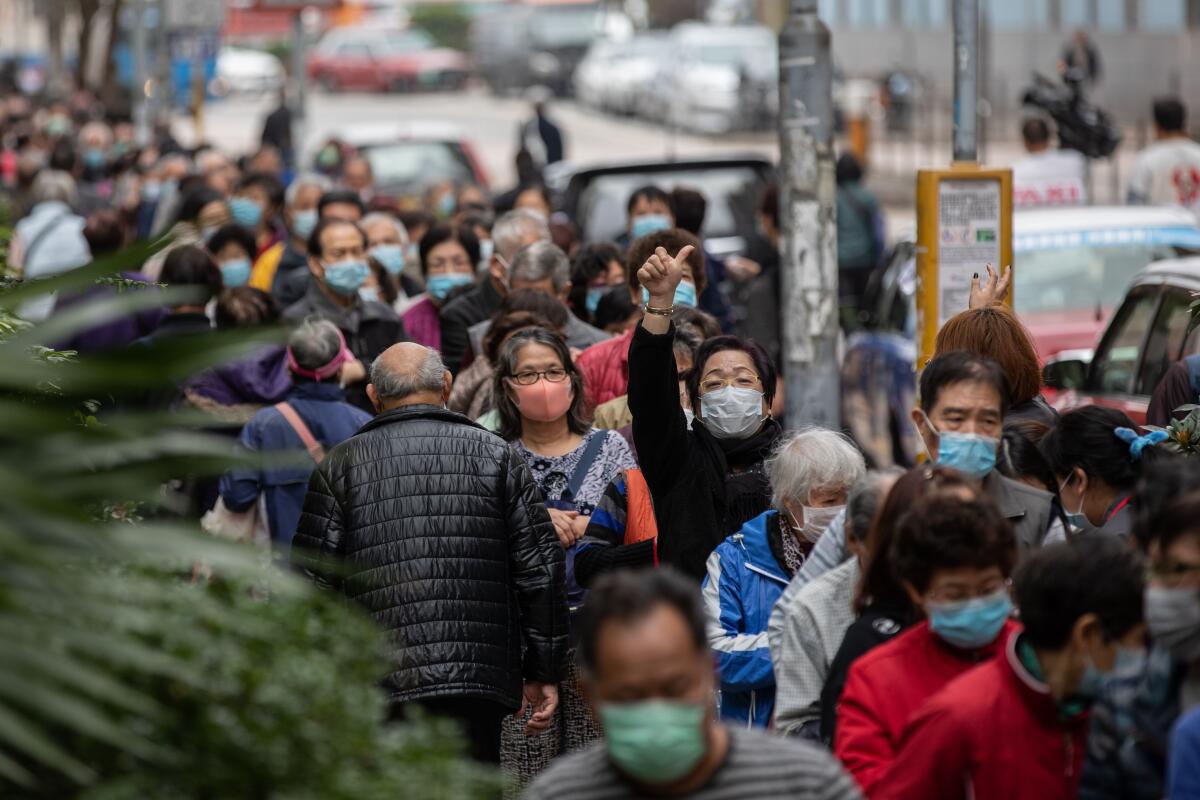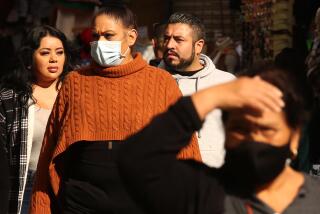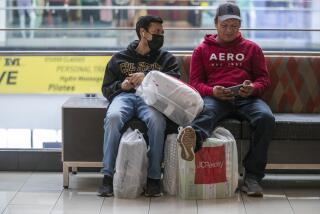Column: Wondering if L.A.’s new mask rules are overkill? Look at the Hong Kong example

- Share via
Hey there, still trapped in your own home, waiting for the all clear?
You can come outside now in the city of Los Angeles and move around a bit, and you can go somewhere other than to the supermarket or to work.
But you’ve got to wear a mask.
On Wednesday, Los Angeles Mayor Eric Garcetti put out the order that says you need to cover your face even for running, cycling and other athletic activities if you live in the city.
If you live in other parts of L.A. County, which has had outdoor mask requirements since mid-April, you’re OK without facial covering as long as nobody is near you.
I know, it’s a little confusing, especially with different specifics in different locales, and with a U.S. president who defiantly refuses to wear a mask even as his health advisors recommend it. Is it any wonder we’ve got pitchfork flare-ups in California and elsewhere on the front lines of the culture war?
But it seems to me that most people in Greater Los Angeles have been in compliance for a while and will continue to play it safe.
Most people.
The guy I saw on a bench on Thursday, waiting for a bus in Eagle Rock with his face fully exposed, had his own ideas about masks and the local and national response to the coronavirus pandemic.
“I think it’s a lot of bunk,” said Eugene, 58.
He told me he has worn a mask at times in congested places, but he thinks the way to beat back the virus is to allow widespread infection that results in herd immunity. He said Sweden is a good example of how to do this, although the record there has been mixed. The economy did not shut down with devastating effects, as it did in the U.S., but Sweden has seen a big spike in deaths compared with some countries.
Eugene’s views aren’t universal, thank goodness. In Long Beach, a retiree named Richard Engel seems to have considerably more faith in the modern scientific establishment. And in masks.
Engel emailed me to say he thinks we can learn something about how to confront the coronavirus from the city of Hong Kong, where his niece lives.
“She feels that the death and infection rates are so low there because virtually everyone wears masks when in public,” said Engel.
He added that in Hong Kong, there had only been four deaths from COVID-19 as of last week.
How can that be?
Hong Kong has a dense population of about 7.5 million while New York City, with a population of 8.4 million, has had more than 27,000 COVID-19 deaths. Los Angeles County, with 10 million people, has recorded 1,700 deaths.
But Engel was right. As of last week, only four deathsin Hong Kong had been attributed to COVID-19. He put me in touch with his niece, Katie de Tilly, who owns an art gallery in Hong Kong. She emailed me to say that when news of a SARS-like virus first appeared in January, “no one and no government official needed to tell people to wear a mask. Literally 99% of the population” did so voluntarily.
Schools were closed early in February, De Tilly said, and people returning to Hong Kong after foreign travel were screened, tracked, and told to quarantine for two weeks. But most businesses, including hers, were able to remain open because there was no surge in cases.
A few days ago, in an article entitled “How Hong Kong Did It,” The Atlantic reported that citizens created their own information networks to analyze and monitor developments, complete with digital maps of outbreak locations. The article said Hong Kong residents defied Carrie Lam, the city’s chief executive, when they thought her response to the pandemic was weak and irresponsible.
“When Lam oscillated between not wearing a mask in public and wearing one but incorrectly,” the Atlantic reported, “they blasted her online and mocked her.”
It’s a heck of a lot easier to manage a city of 8.5 million than a nation of 300 million people during a pandemic. But with nearly 90,000 deaths in the U.S. so far, I wonder how many lives could have been saved if we had followed Hong Kong’s lead three months ago, or ramped up testing early as many Asian countries did.
Richard Engel’s sister Viktoria, a retired teacher, told me she routinely sees people socializing without masks when she goes for her daily walks in Belmont Shore.
“I’ve said a couple of times, ‘Why don’t you put your masks on?’ and they kind of pooh-pooh it and say they don’t need them or don’t know anybody who’s sick,” said Viktoria, who wears a face shield outdoors. “They say, oh, we got through SARS and ebola and all of that and nothing ever happened, and this is like the flu.”
On Thursday, I saw a woman without a mask pushing a shopping cart outside a party supply store in Pasadena. She told me she does wear a mask in grocery stores but thinks the media have over-hyped the coronavirus by focusing on the deaths and not on all the people who get the virus and survive. She also said she didn’t know what to believe about how effective masks are.
Well, wearing a mask doesn’t guarantee that you won’t have a virus particle penetrate it, especially if you’re using a surgical mask or a homemade job rather than higher-grade protection, like such as an N-95. But there’s another consideration that seems to get overlooked.
“I think people are missing the point of masks,” said UCLA epidemiologist Anne Rimoin. “They’re not to protect you from someone else, they’re to protect someone else from you.… The science is pretty clear that if you can reduce droplet spread, you will reduce transmission. Along with social distancing and hand sanitizing, it’s another tool in the box.”
And if the people wearing masks are protecting you, isn’t it right that you should protect them back?
My friend Mark Morocco, an emergency room doctor, said he doesn’t have the benefit of social distancing when a patient comes through the doors.
“Every one of those patients can expose us, unless we are perfect in our PPE, and in the best case, if exposed we’re out of the game for a 14-day quarantine,” Morocco said. “In the worst case? We think about it every day. Masking and social distancing are inconveniences compared to the alternative.”
We are at the point now where the question is not whether to resume some normal activities and get people back to work as soon as possible, but how to do so safely, in the interest of public health and the economy.
From Hong Kong, Katie de Tilly has some words of wisdom in that regard.
“If we could change the mentality to benevolence toward others rather than fear of catching something from someone else or protecting our rights, perhaps it would open people’s hearts toward a shared goal of a better next step in the world,” she said.
“One that includes the golden rule: Do unto others as you would like done unto you. Or in other words, I keep my germs and you keep yours.”
More to Read
Sign up for Essential California
The most important California stories and recommendations in your inbox every morning.
You may occasionally receive promotional content from the Los Angeles Times.











